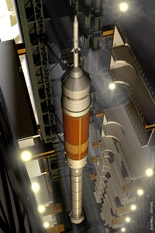
|
 |
An artist's rendition of Ares I being stacked in the vehicle assembly building at NASA's Kennedy Space Center in Florida. Image credit: NASA
|
|
NASA's Constellation Program has selected 11 companies and one university, the University of Maryland, College Park, to independently develop concepts that contribute to how astronauts will live and work on the moon.
Each organization will conduct a 180-day study focused on a topic relevant to lunar surface systems. The Clark School of Engineering will be focusing on Minimum Habitation Functions. Dr. Dave Akin, aerospace engineering associate professor and director of the Space Systems Laboratory, will serve as the principal investigator for the Clark School of Engineering.
Other selected organizations and topics:
* Alternative Packaging Options: Oceaneering Space Systems of Houston
* Avionics: Honeywell International, Inc. of Glendale, Ariz,
* Energy Storage: ATK Space Systems Group of Brigham City, Utah, Battelle Memorial Institute of Columbus, Ohio, and Hamilton Sundstrand of Canoga Park, Calif.
* Minimum Habitation Functions: The Boeing Company of Huntington Beach, Calif., ILC Dover of Frederica, Del., and University of Maryland, College Park
* Regolith Moving Methods: Astrobotic Technology Inc. of Pittsburgh and Honeybee Robotics of New York
* Software: The Charles Stark Draper Laboratory, Inc. of Cambridge, Mass., and United Space Alliance of Houston
The awards total approximately $2 million, with a maximum individual award of $250,000.
"These studies provide new ideas to help the Constellation Program develop innovative, reliable requirements for the systems that will be used when outposts are established on the moon," said Jeff Hanley, the Constellation Program manager at NASA's Johnson Space Center in Houston. The recommendations from the studies will help determine packaging options, identify basic functions for lunar habitats, and conceptualize innovative avionics, computer software, energy storage ideas and equipment and techniques that could help preparation for the lunar outpost site.
The Constellation Program is building NASA's next generation fleet of spacecraft -- including the Ares I and Ares V rockets, the Orion crew capsule, the Altair lunar lander and lunar surface systems -- to send humans beyond low Earth orbit and back to the moon. NASA plans to establish a human outpost on the moon through a successive series of lunar missions beginning in 2020. Lunar surface systems may include habitats, pressurized and un-pressurized rovers, communication and navigation elements, electrical power control, and natural resource use.
For more information about NASA's Constellation Program, visit:
http://www.nasa.gov/constellation
[Information for this article obtained from SpaceRef.com]
Related Articles:
UMD Students Win 2015 RASC-AL Competition
UMD Team Wins 2015 Robo-Ops and Sets New Course Record
Aerospace Students Win in RASC-AL Competition
July 30, 2008
|

